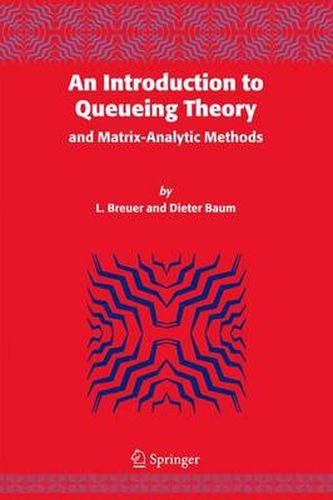Readings Newsletter
Become a Readings Member to make your shopping experience even easier.
Sign in or sign up for free!
You’re not far away from qualifying for FREE standard shipping within Australia
You’ve qualified for FREE standard shipping within Australia
The cart is loading…






This title is printed to order. This book may have been self-published. If so, we cannot guarantee the quality of the content. In the main most books will have gone through the editing process however some may not. We therefore suggest that you be aware of this before ordering this book. If in doubt check either the author or publisher’s details as we are unable to accept any returns unless they are faulty. Please contact us if you have any questions.
The present textbook contains the recordsof a two-semester course on que- ing theory, including an introduction to matrix-analytic methods. This course comprises four hours oflectures and two hours of exercises per week andhas been taughtattheUniversity of Trier, Germany, for about ten years in - quence. The course is directed to last year undergraduate and?rst year gr- uate students of applied probability and computer science, who have already completed an introduction to probability theory. Its purpose is to present - terial that is close enough to concrete queueing models and their applications, while providing a sound mathematical foundation for the analysis of these. Thus the goal of the present book is two-fold. On the one hand, students who are mainly interested in applications easily feel bored by elaborate mathematical questions in the theory of stochastic processes. The presentation of the mathematical foundations in our courses is chosen to cover only the necessary results, which are needed for a solid foundation of the methods of queueing analysis. Further, students oriented - wards applications expect to have a justi?cation for their mathematical efforts in terms of immediate use in queueing analysis. This is the main reason why we have decided to introduce new mathematical concepts only when they will be used in the immediate sequel. On the other hand, students of applied probability do not want any heur- tic derivations just for the sake of yielding fast results for the model at hand.
$9.00 standard shipping within Australia
FREE standard shipping within Australia for orders over $100.00
Express & International shipping calculated at checkout
This title is printed to order. This book may have been self-published. If so, we cannot guarantee the quality of the content. In the main most books will have gone through the editing process however some may not. We therefore suggest that you be aware of this before ordering this book. If in doubt check either the author or publisher’s details as we are unable to accept any returns unless they are faulty. Please contact us if you have any questions.
The present textbook contains the recordsof a two-semester course on que- ing theory, including an introduction to matrix-analytic methods. This course comprises four hours oflectures and two hours of exercises per week andhas been taughtattheUniversity of Trier, Germany, for about ten years in - quence. The course is directed to last year undergraduate and?rst year gr- uate students of applied probability and computer science, who have already completed an introduction to probability theory. Its purpose is to present - terial that is close enough to concrete queueing models and their applications, while providing a sound mathematical foundation for the analysis of these. Thus the goal of the present book is two-fold. On the one hand, students who are mainly interested in applications easily feel bored by elaborate mathematical questions in the theory of stochastic processes. The presentation of the mathematical foundations in our courses is chosen to cover only the necessary results, which are needed for a solid foundation of the methods of queueing analysis. Further, students oriented - wards applications expect to have a justi?cation for their mathematical efforts in terms of immediate use in queueing analysis. This is the main reason why we have decided to introduce new mathematical concepts only when they will be used in the immediate sequel. On the other hand, students of applied probability do not want any heur- tic derivations just for the sake of yielding fast results for the model at hand.